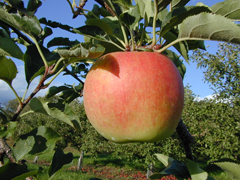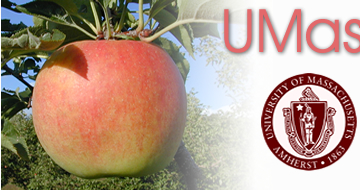| pages: previous 1 2 3 4 5 6 7 8 9 10 11 12 13 14 next |
|
|
Candy Crisp is a newly introduced apple that was discovered as a chance seedling in the Hudson Valley in New York. It is a glossy yellow, and generally russet free apple with an extremely mild, somewhat pear-like flavor. It appears to have low acid content, thus it taste is quite sweet. It is large and very typey with a length/diameter ratio of 1.05 or more, which is higher than most apples in commercial production. In our test trees, there was variability in tree vigor, with some that were quite vigorous while other were somewhat weak. |
Chinook is a small to medium sized apple that has an extensive pinkish red blush on 80 to 90% of the surface. It is very firm and somewhat juicy, but the appearance is not distinctive from many other apples. It is a grower-friendly tree with spreading flat branches, spurry, and quite precocious. It has potential for several month in regular air storage. Photo courtesy of Cheryl Hampson, Agriculture & Agri-Food Canada, Summerland, BC.
|
|
 |
Creston originated in British Columbia. Frequently
Creston is compared with Jonagold, a variety with which it shares many
characteristics including large fruit size, only moderately good color,
firmness, time of ripening, and fruit quality. Fruit are medium to large,
crisp and juicy, pleasant, and refreshing, with a good sugar-to-acid
ratio. It lacks good red color and can be stored for 3 to 4 months. It
can be considered an alternative to Jonagold with a different and pleasant
taste.
|
Crimson Crisp is a newly named variety that originated from the Purdue-Rutgers-Illinois apple disease-resistance breeding program. It was tested as Coop 39. Color is a very attractive, with bright red blush on over 90% of the surface. Fruit are medium in size and flesh is white and very firm. The flavor is pleasant and mild. It is highly resistant to apple scab.
|
 |
| |
Daybreak Fuji. This strain of Fuji is
a limb sport of Yataka Fuji, and it ripens fully 3 to 4 weeks earlier
than the nonmutated Fuji strains. Color is pinkish red and not as intense
as later maturing Fuji strains that have been selected for, among other
things, red color. Firmness and storage potential are less than for regular
Fuji, however, it looks and taste like a Fuji, and this stain provides
an opportunity to market Fuji well in advance of the regular Fuji that
ripens much later in October.
|
| pages: previous 1 2 3 4 5 6 7 8 9 10 11 12 13 14 next |



